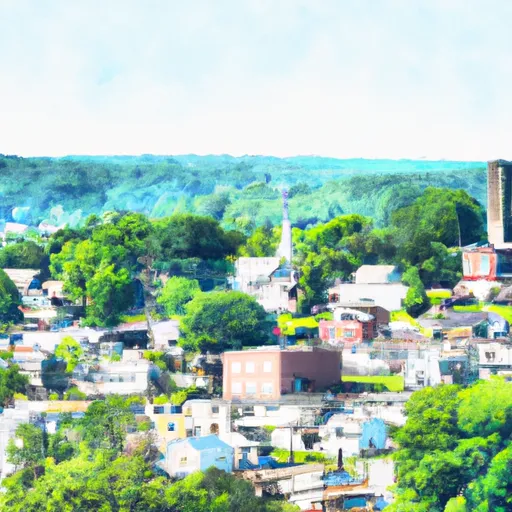-
 Snoflo Premium
Snoflo Premium
Get unlimited access to all our content
With no Ad interruptions! - Start Your Free Trial Login with existing account
Shavertown
Eden Index
Climate
9.0
•
Recreation
3.4
•
Community
4.0
•
Safeguard
5.8/10

Shavertown, Pennsylvania is a small community located in Luzerne County. It experiences a humid continental climate, characterized by mild to hot summers and cold winters. Average high temperatures range from the mid-80s Fahrenheit (29°C) in summer to the mid-30s Fahrenheit (-1°C) in winter. Precipitation is evenly distributed throughout the year, with an annual average rainfall of approximately 40 inches (1016 mm).
The hydrology constituents in and around Shavertown include the Toby Creek and Huntsville Reservoir, which provide water supply to the area. These water bodies offer opportunities for fishing, boating, and other water-based activities. Additionally, the nearby Francis Slocum State Park features a 165-acre lake where visitors can enjoy swimming, kayaking, and picnicking.
For outdoor enthusiasts, Shavertown offers various recreational opportunities. The Back Mountain Trail, a multi-use trail, is perfect for hiking, biking, and jogging. The area is also abundant in natural beauty, with scenic spots like Ricketts Glen State Park and the Pocono Mountains within driving distance. These areas provide opportunities for hiking, camping, fishing, and wildlife observation.
Overall, Shavertown, Pennsylvania offers a diverse climate, hydrology constituents, and a range of outdoor recreation options for residents and visitors alike.
What is the Eden Index?
The Snoflo Eden Index serves as a comprehensive rating system for regions, evaluating their desirability through a holistic assessment of climate health, outdoor recreation opportunities, and natural disaster risk, acknowledging the profound impact of these factors on livability and well-being.
Climate Health Indicator (CHI): 9.0
Shavertown receives approximately
1160mm of rain per year,
with humidity levels near 79%
and air temperatures averaging around
9°C.
Shavertown has a plant hardyness factor of
6, meaning
plants and agriculture in this region thrive during a short period during spring and early summer. Most
plants will die off during the colder winter months.
By considering the ideal temperature range, reliable water supplies, clean air, and stable seasonal rain or snowpacks, the Climate Health Indicator (CHI) underscores the significance of a healthy climate as the foundation for quality living.
A healthy climate is paramount for ensuring a high quality of life and livability in a region, fostering both physical well-being and environmental harmony. This can be characterized by ideal temperatures, reliable access to water supplies, clean air, and consistent seasonal rain or snowpacks.
Weather Forecast
Streamflow Conditions
Upper Susquehanna
Area Rivers
Upper Susquehanna
Snowpack Depths
Upper Susquehanna
Reservoir Storage Capacity
Upper Susquehanna
Groundwater Levels
Recreational Opportunity Index (ROI): 3.4
The Recreational Opportunity Index (ROI) recognizes the value of outdoor recreational options, such as parks, hiking trails, camping sites, and fishing spots, while acknowledging that climate plays a pivotal role in ensuring the comfort and consistency of these experiences.
Access to outdoor recreational opportunities, encompassing activities such as parks, hiking, camping, and fishing, is crucial for overall well-being, and the climate plays a pivotal role in enabling and enhancing these experiences, ensuring that individuals can engage in nature-based activities comfortably and consistently.
Camping Areas
| Campground | Campsites | Reservations | Toilets | Showers | Elevation |
|---|---|---|---|---|---|
| Mauch Chunk Lake County Park | None | 1,050 ft | |||
| Locust Lake State Park | None | 1,260 ft | |||
| Frances Slocum State Park | None | 1,200 ft | |||
| Salt Springs State Park | None | 1,311 ft | |||
| Moon Lake County Park | None | 1,133 ft |
Nearby Fishing
Nearby Ski Areas
Catastrophe Safeguard Index (CSI):
The Catastrophe Safeguard Index (CSI) recognizes that natural disaster risk, encompassing floods, fires, hurricanes, and tornadoes, can drastically affect safety and the overall appeal of an area.
The level of natural disaster risk in a region significantly affects safety and the overall livability, with climate change amplifying these risks by potentially increasing the frequency and intensity of events like floods, fires, hurricanes, and tornadoes, thereby posing substantial challenges to community resilience and well-being.
Community Resilience Indicator (CRI): 4.0
The Community Resilience Indicator (CRI) recognizes that education, healthcare, and socioeconomics are crucial to the well-being of a region. The CRI acknowledges the profound impact of these elements on residents' overall quality of life. By evaluating educational resources, healthcare accessibility, and economic inclusivity, the index captures the essential aspects that contribute to a thriving community, fostering resident satisfaction, equity, and social cohesion.

